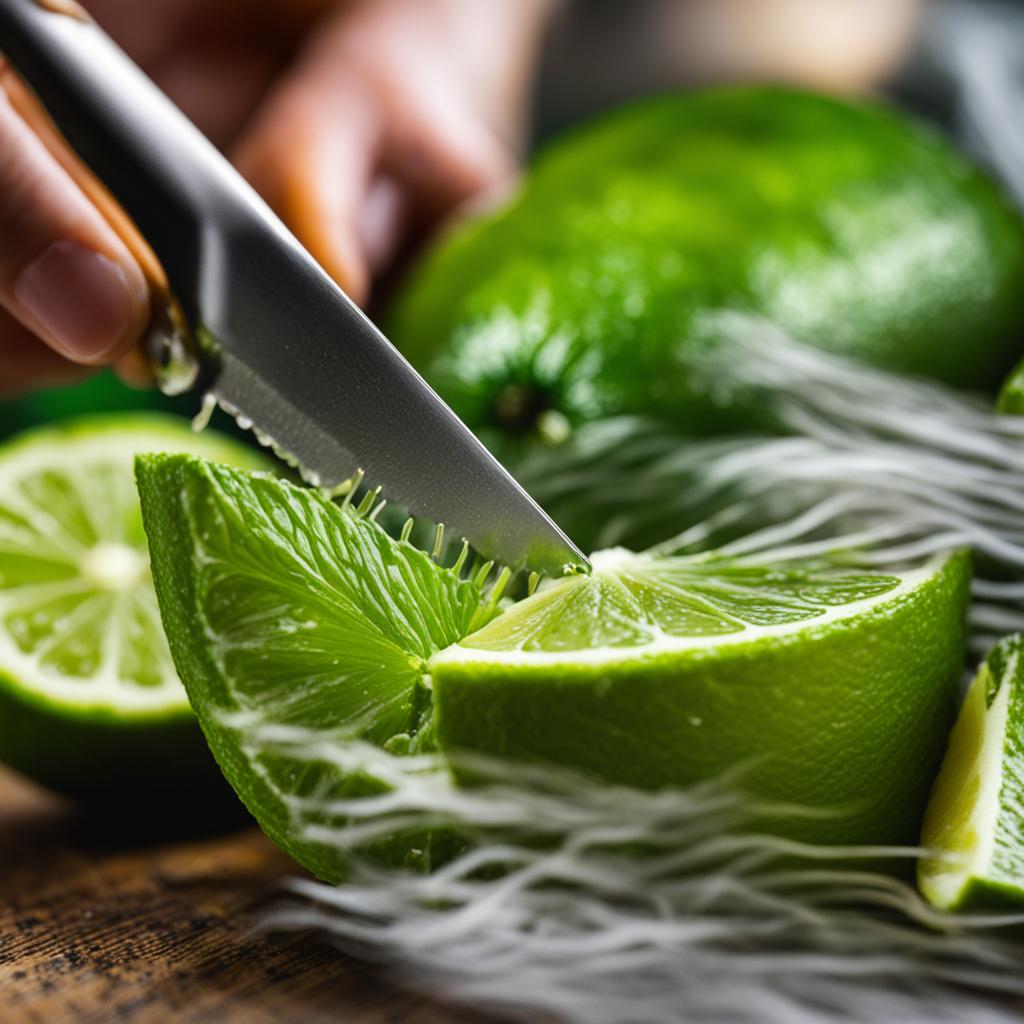Are you in need of a lime zest substitute for your culinary creations? Look no further! In this article, I will share some fantastic alternatives that will keep your dishes zesty and flavorful, even when you’re out of fresh lime zest. Don’t compromise on taste – let me guide you through these exciting options.
Key Takeaways:
- When you run out of fresh lime zest, there are various alternatives you can use to maintain that tangy and citrusy flavor in your recipes.
- Fresh citrus options like lemon zest, bottled lime juice, or other citrus zest can be used as a substitute for lime zest in a 1:1 ratio.
- If you have a lime but no zester, you can still create zest using the lime peel, but be careful to avoid the bitter white part.
- Consider using dried lemon peel, lemon extract, or orange zest as flavorful alternatives to lime zest, depending on your recipe.
- Remember to adjust the quantities and flavors accordingly when substituting lime zest, and store your citrus fruits properly to ensure freshness.
Why You Need a Lime Zest Substitute
Citrus zest, including lime zest, adds a unique aromatic and tangy flavor to dishes due to its citric acid content. However, there are times when you may run out of lime zest. In such cases, it’s helpful to have different substitutes on hand to maintain the desired acidity and flavor profile in your recipes. Let’s explore some alternatives that can come to your rescue in the kitchen.
Citrus Zest Options
- Lemon Zest: Lemon zest can be used as a great alternative to lime zest in many recipes. It offers a similar texture and citrus flavor, although it will infuse your dishes with a lemony taste instead of lime. For instance, if you’re making key lime pie and end up using lemon zest, your pie will have a lemon flavor but retain the same texture. Lemon zest works well in both sweet and savory recipes and can be used as a 1:1 substitute for lime zest.
- Orange Zest: Orange zest can be a good substitute for lime zest, providing a fresh and light citrus taste to your dishes. It works well in both sweet dessert recipes and savory dishes. You can use an equal amount of orange zest as a 1:1 substitute for lime zest in your recipes. Just keep in mind that the flavor will change to that of orange rather than lime, so adjust accordingly based on your desired taste.
- Grapefruit Zest: Grapefruit zest can also be used as a substitute for lime zest, although it has a slightly different flavor profile. It adds a tangy and slightly bitter note to dishes. Use it in a 1:1 ratio to replace lime zest in your recipes, keeping in mind the difference in taste.
Lime Juice as a Substitute
In some recipes, you can use lime juice as a substitute for lime zest. However, it’s important to note that lime juice offers a more sour and tangy taste compared to the fresh flavor of lime zest. Use 1/2 tablespoon of lime juice for every tablespoon of lime zest required in the recipe. Keep in mind that lime juice is wet, so consider recipe adjustments to handle the extra liquid.
The image below showcases the different citrus zest options and their substitutes:
Table: Citrus Zest Substitutes
| Citrus Zest | Substitute |
|---|---|
| Lime Zest | Lemon Zest |
| Orange Zest | |
| Grapefruit Zest | |
| Lime Juice |
Fresh Citrus Options for Lime Zest Substitute
When it comes to substituting lime zest with fresh citrus options, you have a few choices. For every teaspoon of freshly grated lime zest, you can use 1/2 teaspoon of lime extract, 2 tablespoons of bottled lime juice, or 1 teaspoon of lemon zest or other citrus zest, such as grapefruit or oranges. These alternatives will provide a similar tangy and citrusy flavor to your dishes.
Table:
| Lime Zest Substitute | Quantity for 1 teaspoon of Lime Zest |
|---|---|
| Lime Extract | 1/2 teaspoon |
| Bottled Lime Juice | 2 tablespoons |
| Lemon Zest | 1 teaspoon |
| Citrus Zest (Grapefruit, Oranges) | 1 teaspoon |
These alternatives can be easily incorporated into your recipes, providing the same tangy and zesty taste that lime zest offers. Whether you choose to use a concentrated lime extract, bottled lime juice, or other citrus zests, your dishes will still have that bright and citrusy flavor.
Remember to adjust the quantity of the substitute based on your personal preference and the intensity of the flavor you want to achieve. With these fresh citrus options, you can confidently continue with your culinary creations even when you find yourself without lime zest.
Lime Peel as a Zest Substitute
If you find yourself without a zester but still want to enjoy the bright flavor of lime in your dishes, don’t worry! You can use lime peel as a substitute for zest. Here’s how:
- Take a fresh lime and use a pairing knife to carefully peel off just the green part of the lime peel. Be sure to avoid grating the white pith, as it can add a bitter taste to your dishes.
- Once you have peeled the lime, chop the green peel finely to create a substitute for zest.
- Add the finely chopped lime peel to your recipe, using the same amount as you would for zest.
Using lime peel as a zest substitute allows you to infuse your dishes with the bright and tangy flavor of lime without the need for a specialized tool. It’s a simple and effective solution that can come in handy when you don’t have a zester on hand.
Tip: To make the chopping process easier, you can use a citrus zester, which is a handy tool specifically designed for creating zest and peels. It helps you achieve finely chopped lime peel without the risk of grating the bitter pith.
Comparison Table: Lime Peel vs. Lime Zest
| Aspect | Lime Peel | Lime Zest |
|---|---|---|
| Flavor | Bright and tangy | Bright and tangy |
| Preparation | Finely chopped | Grated or finely grated |
| Texture | Chewy | Light and fluffy |
| Usage | Substitute for zest | Main ingredient |
While lime peel can be a great substitute for lime zest, it’s important to note that the texture and preparation method differ slightly. Lime peel is chewy and needs to be finely chopped, whereas lime zest is light and fluffy, achieved by grating or finely grating the peel. However, both options provide a bright and tangy flavor to your dishes, making them suitable alternatives for each other.
Lemon Zest as an Alternative to Lime Zest
When it comes to finding a substitute for lime zest, lemon zest is a fantastic option. Lemon zest offers a similar texture and citrus flavor, making it a suitable replacement in many recipes. For example, if you’re making a lemon pie but don’t have any lime zest, using lemon zest will still give your pie a delightful citrus flavor. Lemon zest works well in both sweet and savory dishes, making it a versatile choice for a lime zest substitute.
If you’re unsure about the exact ratio, you can use lemon zest as a 1:1 substitute for lime zest. This means that if your recipe calls for 1 teaspoon of lime zest, you can use 1 teaspoon of lemon zest instead. Keep in mind that while the flavor will change to lemon, the texture and overall taste of your dish will remain similar. Lemon zest is a popular choice in citrus desserts, cocktails, and various other dishes where a burst of citrus flavor is desired.
When using lemon zest as a substitute, remember to zest the lemon carefully to avoid getting any of the bitter white pith. The zest contains the flavorful oils from the lemon’s outer peel, while the pith can add unwanted bitterness to your dish. With proper zesting technique and the right amount of lemon zest, you can enjoy the bright and tangy taste that lime zest brings to your recipes.
“Lemon zest can be a great alternative to lime zest in many recipes, offering a similar texture and citrus flavor.”
Orange Zest as a Substitute for Lime Zest
If you’re looking for a fresh and light citrus taste in your recipes, orange zest can be a great substitute for lime zest. It offers a vibrant flavor that works well in both sweet dessert recipes and savory dishes. With its bright and citrusy notes, orange zest can add a delightful twist to your culinary creations.
To use orange zest as a substitute for lime zest, simply follow a 1:1 ratio. This means that for every teaspoon of lime zest required in your recipe, you can use an equal amount of orange zest. Keep in mind that while the flavor will change to that of orange, the overall taste profile of your dish will still be enhanced by the fresh and tangy notes of the citrus fruit.
Whether you’re making a refreshing citrus salad, a zesty marinade, or a citrus-infused dessert, orange zest can bring a burst of flavor to your dishes. Its versatility allows you to experiment with different recipes and explore new taste combinations. So, don’t hesitate to reach for orange zest when you need a substitute for lime zest in your cooking.
| Lime Zest | Orange Zest |
|---|---|
| Distinctly tart and tangy flavor | Fresh and light citrus taste |
| Works well in savory recipes | Great for sweet dessert recipes |
| Intense and zesty aroma | Slightly sweeter fragrance |
H3: Tips for Using Orange Zest as a Substitute
- Grate the zest from fresh, ripe oranges for the best flavor.
- Avoid grating the white pith of the orange peel, as it can add a bitter taste.
- Adjust the quantity of orange zest based on your personal preference and the desired level of citrus flavor in your recipe.
- Consider the color change that may occur when using orange zest instead of lime zest, especially in recipes where the vibrant green color of lime zest is desired.
“Orange zest adds a delightful twist to both sweet and savory dishes, bringing a fresh and light citrus taste that can elevate your culinary creations.”
Lime Juice as a Lime Zest Substitute
In some recipes, you can use lime juice as a substitute for lime zest. However, it’s important to note that lime juice offers a more sour and tangy taste compared to the fresh flavor of lime zest. Use 1/2 tablespoon of lime juice for every tablespoon of lime zest required in the recipe. Keep in mind that lime juice is wet, so consider recipe adjustments to handle the extra liquid.
While lime juice can provide a similar tanginess to your dishes, it lacks the aromatic and fragrant qualities of lime zest. The zest contains essential oils that add depth and complexity to the flavor profile. However, in a pinch, lime juice can still add a bright and citrusy element to your recipes.
When using lime juice as a substitute, be mindful of the recipe’s overall balance. The sour and tangy taste of the juice may need to be offset with other ingredients to ensure a harmonious flavor. Adjusting the other flavors in the recipe, such as sweetness or saltiness, can help counterbalance the acidity of the lime juice.
Dried Lemon Peel for Lime Zest Replacement
When it comes to finding a versatile substitute for lime zest, dried lemon peel is a fantastic option. It offers an intense flavor that can elevate your dishes to new heights. With dried lemon peel, you can achieve the same zingy and citrusy taste that lime zest provides, but with a slightly different twist.
One of the great advantages of using dried lemon peel is that you can use two-thirds less compared to the amount of zest called for in a recipe. For example, if a recipe calls for 1 tablespoon of lime zest, you can use just 1/3 tablespoon of dried lemon peel. This means that a little goes a long way, making it a cost-effective choice as well.
Dried lemon peel works well in both sweet and savory recipes, making it a versatile substitute. Its intense flavor pairs beautifully with a range of dishes, from tangy desserts to savory marinades. So the next time you find yourself out of lime zest, reach for dried lemon peel and discover a whole new world of citrusy deliciousness.
| Lime Zest | Dried Lemon Peel |
|---|---|
| Intense citrus flavor | Intense citrus flavor |
| Required quantity: 1 tablespoon | Required quantity: 1/3 tablespoon |
| Provides a bright and zesty taste | Brings a unique twist to dishes |
As you can see, dried lemon peel offers an intense flavor that matches the citrusy goodness of lime zest. By using two-thirds less than the amount of zest called for in a recipe, you can maintain a perfect balance of flavors. So don’t hesitate to experiment with dried lemon peel as a substitute for lime zest and add a burst of citrusy delight to your culinary creations.
Lemon Extract: A Burst of Intense Flavor for Your Culinary Creations
When it comes to infusing your dishes with a burst of intense citrus flavor, lemon extract is a versatile and powerful ingredient to have in your pantry. Made by soaking lemon peels in alcohol, lemon extract boasts a concentrated lemon taste that can elevate your recipes. With a 1:2 ratio of lemon extract to lime zest, you can use this substitute to add a bold citrus kick to your favorite bakery items and marinades.
Lemon extract provides a concentrated burst of citrus flavor, making it perfect for enhancing the taste of your baked goods. Whether you’re baking a lemon-infused cake, cookies, or muffins, adding a touch of lemon extract can elevate the overall taste. Just remember to use half the amount of lemon extract compared to the required lime zest in your recipe to achieve the desired flavor intensity.
In savory dishes, lemon extract can be used to brighten up marinades for chicken, fish, or vegetables. Its intense flavor adds depth and complexity, making your dishes more vibrant and tantalizing to the taste buds. Keep in mind that lemon extract is highly concentrated, so a little goes a long way. Start with small quantities and taste as you go to ensure you don’t overpower the other flavors in your recipe.
Table: Lemon Extract Usage Tips
| Lemon Extract Usage Tips | |
|---|---|
| 1. Use a 1:2 ratio of lemon extract to lime zest in your recipes. | |
| 2. Start by adding small quantities of lemon extract and taste as you go to avoid overpowering other flavors. | |
| 3. Lemon extract works best in baked goods and marinades. | |
| 4. Be mindful of the intense flavor of lemon extract and adjust the amount according to your personal preference. |
With its intense flavor and versatility, lemon extract can be a valuable tool in your culinary arsenal. Whether you’re looking to add a zing to your desserts or elevate the savory profile of your dishes, this substitute will surely deliver a burst of mouthwatering citrus goodness. So go ahead, embrace the bright and bold flavors of lemon extract, and take your culinary creations to new heights.
Factors to Consider When Substituting Lime Zest
When substituting lime zest in your recipes, there are a few important factors to consider. These factors can help you achieve the desired results and maintain the delicious flavor profile of your dishes. Let’s take a closer look at what you need to keep in mind:
Recipe Quantity
The quantity of zest needed in your recipe will impact the amount of substitute required. Be sure to adjust the measurements accordingly to ensure the right balance of flavors. Whether you’re doubling a recipe or making a smaller portion, keep a close eye on the amount of zest needed and make the necessary adjustments.
Acidity Level and Flavor Profile
While lime zest substitutes can provide a similar tangy and citrusy flavor, it’s important to note that the acidity level and flavor profile may vary slightly. Different substitutes like lemon zest or orange zest can add their unique characteristics to the dish. Consider the overall taste you’re aiming for and adjust the substitute accordingly to achieve the desired flavor balance.
Color Adjustment
Using certain substitutes, such as orange zest, may impact the color of the finished dish. Orange zest has a different pigment compared to lime zest, and this can affect the visual appeal of your recipe. If the color is an important aspect of your dish, keep in mind that substituting with orange zest may result in a different hue.
| Factors to Consider | Considerations |
|---|---|
| Recipe Quantity | Adjust measurements based on the quantity needed. |
| Acidity Level and Flavor Profile | Understand the unique characteristics and adjust accordingly. |
| Color Adjustment | Be aware of the impact on the visual presentation of the dish. |
By taking these factors into account, you can make informed decisions when substituting lime zest in your culinary creations. Remember to taste as you go and make adjustments as needed to ensure your dishes are zesty, flavorful, and visually appealing.

Lime Zest Substitutes for Your Cooking Needs
When it comes to lime zest substitutes, it’s essential to have a good understanding of the shelf life of citrus fruits and proper storage methods. By knowing how long your fruits will last and how to keep them fresh, you’ll always have emergency substitutions available in your kitchen.
For optimal shelf life, lemons, limes, and oranges should be stored in the refrigerator. Lemons and limes can last up to two weeks when refrigerated, while oranges can stay fresh for up to four weeks. This extended lifespan ensures that you’ll have a supply of fresh citrus on hand whenever you need it for zest or other culinary purposes.
When it comes to emergency substitutions, having a chart or list of alternatives can be incredibly helpful. Consider creating a visual reference that highlights the different options for replacing lime zest in your recipes. This way, you can easily identify which substitute to use based on what you have available in your pantry.
| Citrus Fruit | Substitute |
|---|---|
| Lime | 1/2 teaspoon of lime extract |
| 2 tablespoons of bottled lime juice | |
| 1 teaspoon of lemon zest | |
| 1 teaspoon of other citrus zest (grapefruit, oranges) |
By keeping your citrus fruits refrigerated and having a comprehensive list of substitutes, you’ll never have to worry about running out of lime zest again. Enjoy the freedom to experiment with different flavors and keep your dishes zesty and flavorful.
The Versatility of Lime Zest Substitutes
When it comes to cooking hacks, lime zest substitutes offer a world of flavor enhancement and recipe rescue. These versatile alternatives allow you to keep your dishes zesty and flavorful, even when you don’t have fresh lime zest on hand. Whether you’re looking for a quick ingredient swap or want to explore new taste dimensions, lime zest substitutes have got you covered.
The key to successful flavor enhancement lies in choosing the right substitute for your recipe. Consider using fresh citrus options such as lemon zest, orange zest, or even grapefruit zest. These alternatives provide a similar tangy and citrusy flavor profile to lime zest, ensuring that your dishes retain their vibrant taste. Additionally, you can rely on lime juice as a quick and easy substitute when the recipe calls for acidity and a sour tangy taste.
Switching up your ingredients with lime zest substitutes not only adds depth to your culinary creations but also allows you to experiment with new flavors. Whether you’re making sweet desserts or savory dishes, these substitutes provide a versatile canvas for your culinary adventures. Don’t be afraid to embrace the possibilities and let your taste buds guide you as you explore the world of lime zest substitutes.
| Substitute | Measurement | Flavor Profile |
|---|---|---|
| Fresh Citrus Zest (lemon, orange, grapefruit) | 1 teaspoon per teaspoon of lime zest | Tangy and citrusy |
| Lime Juice | 1/2 tablespoon per tablespoon of lime zest | Sour and tangy |
| Dried Lemon Peel | 1/3 tablespoon per tablespoon of lime zest | Intense flavor |
| Lemon Extract | 1/2 teaspoon per teaspoon of lime zest | Concentrated citrus flavor |
With these flavor-packed substitutes at your disposal, you can confidently embark on your culinary journey. Whether you’re looking to rescue a recipe or simply wanting to try something new, lime zest substitutes are here to elevate your cooking game. So don’t be afraid to swap, substitute, and savor the incredible flavors that lime zest substitutes bring to the table.
Culinary Arts: Mastering the Art of Zesting and Extracting Citrus Flavors
The art of zesting and extracting citrus flavors is an essential skill in the culinary arts. It involves extracting the flavorful essential oils from citrus fruits such as lemons, limes, and oranges to enhance the taste of various dishes. As a chef, understanding the proper techniques for zesting and extracting citrus flavors ensures quality assurance and elevates the overall culinary experience.
When it comes to zesting citrus fruits, it’s important to use the right tools. A citrus zester or a microplane grater is ideal for gently removing the zest from the fruit without getting too much of the bitter white pith. The zest, which is the colorful outer layer of the fruit’s peel, contains the essential oils that provide the citrusy aroma and taste to your dishes.
To extract citrus flavors, you can use various techniques. One common method is by using a citrus juicer or reamer to squeeze out the juice from the fruit. This juice can then be used in recipes to add a tangy and acidic flavor. Additionally, you can also use a fine mesh strainer to remove any pulp or seeds and obtain a smooth citrus juice.

Strengthen your culinary skills by mastering the art of zesting and extracting citrus flavors. The proper techniques ensure the inclusion of essential oils and elevate the quality and taste of your recipes.
Tips for Zesting and Extracting Citrus Flavors:
- Choose firm and unblemished citrus fruits for the best zest and flavor.
- Gently roll the fruit on a hard surface before zesting or juicing to release the essential oils.
- When zesting, avoid applying too much pressure to prevent getting the bitter white pith.
- Rotate the fruit while zestin to ensure you get all the flavorful oils from the entire surface.
- When juicing, warm the fruit slightly or roll it on the countertop to make it easier to extract the juice.
- Store any leftover zest or juice in airtight containers in the refrigerator for future use.
By mastering the art of zesting and extracting citrus flavors, you can enhance the taste and aroma of your culinary creations. Whether you’re adding a hint of lime zest to a refreshing cocktail or infusing a lemony taste into a savory dish, these skills will elevate your cooking to new heights of flavor and creativity.
The Magic of Citrus Zest in Culinary Creations
Citrus zest, including lime zest, adds a touch of magic to culinary creations. The bright and fresh flavors it imparts elevate the taste of various dishes, ranging from desserts and beverages to cocktails and sauces. Embracing the versatility of zest alternatives expands your food knowledge and enhances your overall eating experience. Experiment with different options and discover the wonders of citrus zest in your cooking.
When it comes to cooking, the use of citrus zest can transform a dish from ordinary to extraordinary. The vibrant flavors of lime, lemon, and orange zest add a burst of freshness and tanginess that can elevate the taste of any recipe. Whether you’re making a zesty lemon tart or a refreshing lime-infused salsa, using citrus zest can take your culinary creations to new heights.
One of the great things about citrus zest is its versatility. You can use it in both sweet and savory dishes, and it pairs well with a wide variety of ingredients. The zest adds a bright and tangy note that balances the flavors in a dish and brings out the natural sweetness of other ingredients. It can be used as a finishing touch to add a pop of color and flavor, or it can be incorporated into the cooking process to infuse the entire dish with its citrusy goodness.
When using citrus zest in your recipes, be sure to use a microplane or zester to get the fine, delicate strands of zest. This will give you the best flavor and texture. You can also experiment with different types of citrus fruits to create unique flavor combinations. For example, combining lemon and lime zest can give your dish a more complex and layered citrus flavor. So don’t be afraid to get creative and explore the magic of citrus zest in your culinary adventures!
Conclusion
After exploring various lime zest substitutes, it’s clear that you don’t have to compromise on flavor in your culinary adventures. Whether you choose to use fresh citrus options like lemon and orange zest or explore alternatives like lime juice or extracts, there are plenty of options to keep your dishes zesty and flavorful.
By incorporating these substitutes into your recipes, you can still achieve the bright and tangy taste that lime zest adds. Whether you’re making desserts, savory dishes, or refreshing beverages, the flavor profiles of these substitutes will enhance your culinary creations.
So, the next time you find yourself out of lime zest, don’t panic. Instead, embrace the opportunity to experiment and let your creativity and palate guide you to exciting new taste experiences in the kitchen. With these lime zest substitutes in your culinary arsenal, your dishes will continue to be zesty and flavorful, adding a delicious twist to your cooking adventures.
FAQ
What can I use as a substitute for lime zest in recipes?
You can use alternatives like lime extract, bottled lime juice, lemon zest, or other citrus zests such as grapefruit or oranges. These options will provide a similar tangy and citrusy flavor to your dishes.
Can I use lime peel as a substitute for lime zest?
Yes, you can! Carefully peel the green part of the lime peel with a paring knife and chop it finely to use as a substitute for zest in your recipe. Just make sure to avoid grating the white part of the lime peel, as it can give a bitter taste to your dishes.
Can I substitute lemon zest for lime zest?
Absolutely! Lemon zest can be used as a great alternative to lime zest in many recipes. It offers a similar texture and citrus flavor, although it will infuse your dishes with a lemony taste instead of lime. You can use lemon zest as a 1:1 substitute for lime zest.
What about using orange zest as a substitute for lime zest?
Yes, orange zest can be a good substitute for lime zest, providing a fresh and light citrus taste to your dishes. It works well in both sweet dessert recipes and savory dishes. You can use an equal amount of orange zest as a 1:1 substitute for lime zest in your recipes.
Can I use lime juice as a substitute for lime zest?
Yes, you can use lime juice as a substitute for lime zest in some recipes. Keep in mind that lime juice offers a more sour and tangy taste compared to the fresh flavor of lime zest. Use 1/2 tablespoon of lime juice for every tablespoon of lime zest required in the recipe, and consider recipe adjustments to handle the extra liquid.
What if I don’t have any fresh citrus options for a lime zest substitute?
If you don’t have any fresh citrus available, you can use dried lemon peel as a substitute for lime zest. Use two-thirds less dried lemon peel than the amount of zest called for in a recipe. Dried lemon peel works well in both sweet and savory recipes, making it a versatile substitute for lime zest.
How can I use lemon extract as a substitute for lime zest?
Lemon extract can be a great substitute for lime zest when you want to add an intense citrus flavor to your dish. Use 1/2 teaspoon of lemon extract for every teaspoon of lime zest required in the recipe, maintaining a 1:2 ratio. Lemon extract works well in bakery items, marinades, and other recipes where a bold lemon flavor is desired.
What factors should I consider when substituting lime zest?
When substituting lime zest, consider the quantity of zest needed in the recipe, as it impacts the amount of substitute required. Additionally, the acidity level and flavor profile of the substitute may vary slightly from lime zest, so adjust accordingly. Lastly, certain substitutes, like orange zest, may impact the color of the finished dish due to its different pigment.
How should I store citrus fruits for zest and substitutions?
To ensure you always have fresh citrus zest and substitutes on hand, it’s essential to properly store your citrus fruits. Lemons, limes, and oranges have long shelf lives and can be stored in the refrigerator for up to two weeks. By keeping these fruits stocked in your kitchen, you’ll be prepared for any unexpected need for zest or substitutions.
What are the benefits of using lime zest substitutes in cooking?
Lime zest substitutes offer versatility in the kitchen, allowing you to experiment with different flavors and adjust recipes based on ingredient availability. These substitutes can enhance the flavor of your dishes, rescue recipes in times of need, and provide creative ingredient swaps. Explore the culinary possibilities that lime zest substitutes offer and elevate your cooking game to new heights.
How can I improve my culinary skills related to zesting and extracting citrus flavors?
Learning the art of zesting and extracting citrus flavors is essential for any aspiring chef. These techniques provide a depth of flavor to your dishes and ensure the inclusion of essential oils from the citrus fruit. Whether you’re using fresh zest, zest substitutes, or extracts, mastering these culinary skills will enhance the quality and taste of your recipes.
What makes citrus zest so special in culinary creations?
Citrus zest, including lime zest, adds a touch of magic to culinary creations. The bright and fresh flavors it imparts elevate the taste of various dishes, ranging from desserts and beverages to cocktails and sauces. Embracing the versatility of zest alternatives expands your food knowledge and enhances your overall eating experience. Experiment with different options and discover the wonders of citrus zest in your cooking.
Do I have to compromise on flavor if I use a substitute for lime zest?
When it comes to lime zest substitutes, you don’t have to compromise on flavor in your culinary adventures. Whether using fresh citrus options like lemon and orange zest or exploring alternatives like lime juice or extracts, you can still achieve zesty and flavorful dishes. Keep these substitutes in mind for times when you’re out of lime zest, and let your creativity and palate guide you to exciting new taste experiences in the kitchen.
Source Links
- https://homecookbasics.com/lime-zest-substitute/
- https://www.bhg.com/recipes/how-to/cook-with-fruits-and-vegetables/zest-substitute/
- https://www.tasteofhome.com/article/easy-lemon-zest-substitutes/
Related Recipes:
 All About Lemon Zest: How to Use It
All About Lemon Zest: How to Use It
 Lemon Zest Substitute: Best Alternatives
Lemon Zest Substitute: Best Alternatives
 Everything You Need to Know About Lime Zest
Everything You Need to Know About Lime Zest
 How to Cut an Orange? (Step-By-Step Guide)
How to Cut an Orange? (Step-By-Step Guide)
 How to Cut an Orange: Techniques for Perfect Slices
How to Cut an Orange: Techniques for Perfect Slices
 How to Store Citrus Fruits for Best Flavor
How to Store Citrus Fruits for Best Flavor
 How to Store Oranges? (Perfect Every Time!)
How to Store Oranges? (Perfect Every Time!)
 Spotting Bad Lemons: What to Look For
Spotting Bad Lemons: What to Look For








